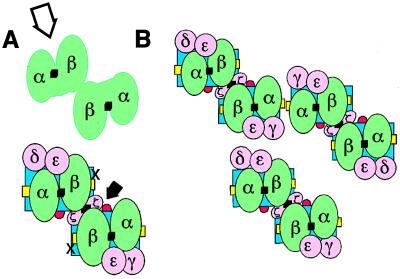Figure 4.
Hypothetical model of (αβTCR)2/CD3 complex. (A) Packing of two αβTCR in a single TCR/CD3 complex. Disulfide bridges in each αβTCR heterodimer or in the ζ homodimer are depicted as black squares. The blue rectangles represent two antiparallel MHC class II molecules presenting the specific peptides (yellow strands). The surface of the αβTCR interface opposite to the CD3 pocket is flat; for simplicity, ovals have been used in most cases. Different isoforms of TCR have been reported with regard to the CD3/ζ module usage, which is reviewed in ref. 54. For simplicity, only the three most common transduction modules are included. (B) The hexameric antigen/MHC packing arises after homotypical aggregation of TCRs and coreceptors, as observed from the T cell nuclei looking toward the APC. Oligomerization occurs in the two dimensions of the T cell and APC membrane after the TCR/CD3 complexes have engaged specific antigen/MHC complexes. The specific TCR ligands are monomers that are rare and occur naturally dispersed on the APC surface among a majority population of irrelevant antigen/MHC complexes but may be concentrated to the T cell/APC interface by the constitutively divalent TCRs.

